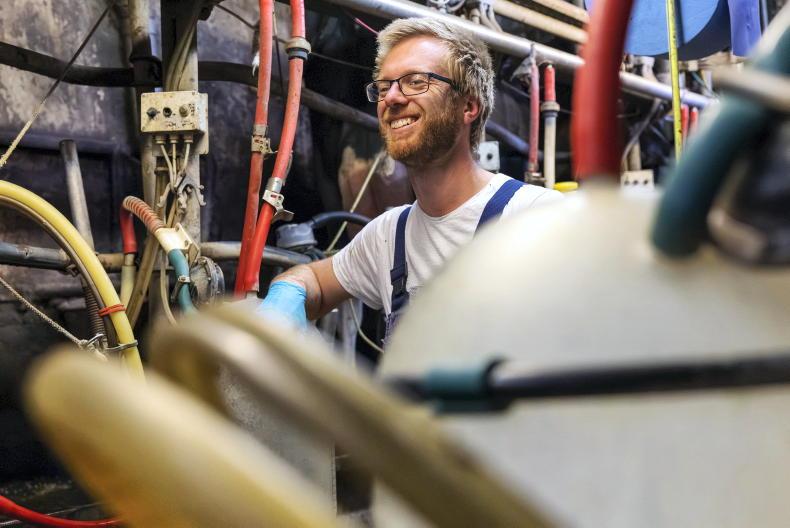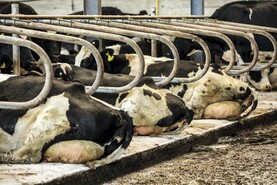Speaking at the Irish Farmers Journal Dairy Day 2024 is young dairy farmer Auko Sikkenga from Groningen, the northernmost province of the Netherlands.
Sikkenga milks between 100 and 110 cows alongside his wife, with the duo also carrying 60 to 70 youngstock across 75ha of light clay soils, some of which is in tillage.
The herd averaged 10,445l at 4.39% fat and 3.63% protein last year to leave solids at 838kg/cow. Supplying FrieslandCampina, the pair are currently receiving 55c/l for their milk, excluding bonuses.
Cows are grazed from April to September and the grassland portion of the farm grows an average of 12t DM/ha, but Sikkenga says the farm is not particularly focused on maximising grazed grass.
Some 50ha of grassland was purchased by Sikkenga and his parents in 2017 half an hour away from the home dairy farm and an adjoining grassland 7ha block was also leased at this time to allow Auko farm in his own right.
“It was just grass and then we get the opportunity to buy some really light clay land from a crop farmer who retired and from then on, we started growing some corn and some wheat,” he explained.
“With the derogation ending, we started to plough some more grassland so we grow some more maize and some more wheat, renting more land out for seed potatoes.”
The feed growing potential of maize and cereals over grass was a key factor in the decision to get into tillage.
The regulatory landscape in the Netherlands has shifted significantly since the farm was bought seven years ago, with an annual stocking rate limit reduction since 2023 and a blanket stocking rate limit of 170kg organic N/ha will apply the Netherlands after 2025.
€25/t to export slurry
The Sikkengas pay €25/t to export slurry to a neighbouring tillage farmer to comply with the stepped down reduction in stocking rates.
“We are on the edge of grassland and cropland, so for us, it’s not too hard to get rid of manure. We pay to get rid of it,” he said.
Sikkenga insists that “the knife must cut both ways” so he buys grain and straw from the farmer receiving the slurry as part of the deal, in addition to paying the €25/t.

Auko Sikkenga's farms 20km outside the city of Groningen in the north of the Netherlands.
Auko sees loan repayments as posing a bigger issue, with funds borrowed for purchasing land subject to high interest rates.
“The way I look at it, the next two years are going to be challenging because we have to find a way with the manure, but then it has to settle down a bit,” he continued.
“It is what to do with the manure, what to do without derogation and what new rules the government will introduce, but after that we will be fine again.
“Losing the derogation is a big deal, but the interest rates are way up too compared with three or four years ago. That is a big deal too for us as young farmers who just bought a farm. The interest rates are a bigger threat to losing the derogation.”
Some farmers bowing out
The Netherlands also saw schemes introduced over the past year where the government will buy out farmers’ rights to farm livestock.
“The government buys your farm, buys your rights to produce manure and there is 500 to 600 farmers who applied out of 12,000 dairy farmers. That is already 5% of the dairy farmers.
“In my area, the 50 years-plus farmers with no successor are reducing numbers but there is still a group of regular to large sized farmers who are just carrying on. They will find somewhere for the manure.”
Despite the challenges facing the Dutch dairy sector, from tight margins, to the major shift in stocking rate goalposts, Auko still sees a future in dairy farming.
“Dairy prices are good and after that, I still think people will still drink milk so we will need dairy farmers.
“The way I look at it, if you get high production from your cows with good health and good welfare, you will still make money.”
Read more
New pre-Dairy Day tours for discussion groups
Speaking at the Irish Farmers Journal Dairy Day 2024 is young dairy farmer Auko Sikkenga from Groningen, the northernmost province of the Netherlands.
Sikkenga milks between 100 and 110 cows alongside his wife, with the duo also carrying 60 to 70 youngstock across 75ha of light clay soils, some of which is in tillage.
The herd averaged 10,445l at 4.39% fat and 3.63% protein last year to leave solids at 838kg/cow. Supplying FrieslandCampina, the pair are currently receiving 55c/l for their milk, excluding bonuses.
Cows are grazed from April to September and the grassland portion of the farm grows an average of 12t DM/ha, but Sikkenga says the farm is not particularly focused on maximising grazed grass.
Some 50ha of grassland was purchased by Sikkenga and his parents in 2017 half an hour away from the home dairy farm and an adjoining grassland 7ha block was also leased at this time to allow Auko farm in his own right.
“It was just grass and then we get the opportunity to buy some really light clay land from a crop farmer who retired and from then on, we started growing some corn and some wheat,” he explained.
“With the derogation ending, we started to plough some more grassland so we grow some more maize and some more wheat, renting more land out for seed potatoes.”
The feed growing potential of maize and cereals over grass was a key factor in the decision to get into tillage.
The regulatory landscape in the Netherlands has shifted significantly since the farm was bought seven years ago, with an annual stocking rate limit reduction since 2023 and a blanket stocking rate limit of 170kg organic N/ha will apply the Netherlands after 2025.
€25/t to export slurry
The Sikkengas pay €25/t to export slurry to a neighbouring tillage farmer to comply with the stepped down reduction in stocking rates.
“We are on the edge of grassland and cropland, so for us, it’s not too hard to get rid of manure. We pay to get rid of it,” he said.
Sikkenga insists that “the knife must cut both ways” so he buys grain and straw from the farmer receiving the slurry as part of the deal, in addition to paying the €25/t.

Auko Sikkenga's farms 20km outside the city of Groningen in the north of the Netherlands.
Auko sees loan repayments as posing a bigger issue, with funds borrowed for purchasing land subject to high interest rates.
“The way I look at it, the next two years are going to be challenging because we have to find a way with the manure, but then it has to settle down a bit,” he continued.
“It is what to do with the manure, what to do without derogation and what new rules the government will introduce, but after that we will be fine again.
“Losing the derogation is a big deal, but the interest rates are way up too compared with three or four years ago. That is a big deal too for us as young farmers who just bought a farm. The interest rates are a bigger threat to losing the derogation.”
Some farmers bowing out
The Netherlands also saw schemes introduced over the past year where the government will buy out farmers’ rights to farm livestock.
“The government buys your farm, buys your rights to produce manure and there is 500 to 600 farmers who applied out of 12,000 dairy farmers. That is already 5% of the dairy farmers.
“In my area, the 50 years-plus farmers with no successor are reducing numbers but there is still a group of regular to large sized farmers who are just carrying on. They will find somewhere for the manure.”
Despite the challenges facing the Dutch dairy sector, from tight margins, to the major shift in stocking rate goalposts, Auko still sees a future in dairy farming.
“Dairy prices are good and after that, I still think people will still drink milk so we will need dairy farmers.
“The way I look at it, if you get high production from your cows with good health and good welfare, you will still make money.”
Read more
New pre-Dairy Day tours for discussion groups







 This is a subscriber-only article
This is a subscriber-only article










SHARING OPTIONS: